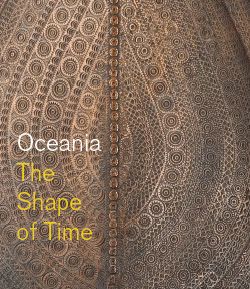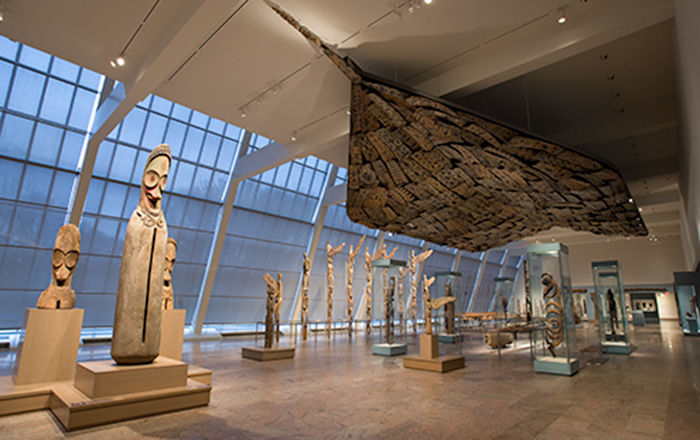Lightning and the Rock
Nonggirrnga Marawili Australian
Not on view
Nonggirrnga Marawili selects her key subjects—fire, water, lightning, rock—from the elemental substances and transformative forces of the natural world. In the tropical climate of northern Australia, fire and water animate the seasons and bring life to the environment—causing the bush to burn, bringing monsoonal rains, summoning lightning and storm clouds: all vital events that sustain life. This suite of four works are a meditation on one particular aspect of this dynamic landscape: trails of carefully placed dots of thick pigment evoke the sea spray cast by waves crashing on rocks and the flickering of lightning as it flashes across the sky. Offering a visual poetics that draws on the detail and beauty of the natural environment, Nonggirrnga Marawili captures the details that reflect a life lived with close attention to the natural world and its instances of fleeting beauty.
Hewn from large rectangular strips of stringy bark from the eucalyptus tree, the uneven surfaces of these four bark paintings are each primed with a single wash of color which enhances the natural contours of its undulating form. The natural earth pigments (white and light pink clay, russet brown ochre and black charcoal) are mixed with PVA glue as a binder creating a paint of thick, fairly unctuous consistency. Using a fine human hair brush, the artist works methodically and systematically, laying down fluid trails of parallel lines that flicker across the length of the painting creating a dynamic frame at the outer edges and leaving an open space of contrasting color at the center. Black, russet brown and pale pink—the empty ground of three of the four paintings creates a backdrop for the dynamism of the lightning strikes evoked at the edges of each work. These three works can be seen as preliminary stages in the artists’ exploration of this particular phenomenon - the flicker of lightning across the sky; the dramatic spray of salt water as it connects with the underwater rock on the coast at the sacred site of Baraltja. Madayin miny’tji are the unique geometric designs owned by Yolngu clans and used in ceremonial contexts. Only in the fourth and final work, does the artist unite these disparate networks of lines as a means to draw together the opposite ends of the painting and its borders—to establish and resolve the energy of miny’tji, the dynamic clan designs perceived by Yolngu that proliferate in, and actively punctuate the landscape.
Nonggirrnga Marawili is the daughter of the Madarrpa warrior Mundukul (lightning snake) and a Galpu woman, Bulunguwuy. A highly respected senior artist in her community, she is a prolific producer of art. Her work includes bark paintings, memorial poles (larrakitj) and limited edition prints. Madayin miny’tji are the unique geometric designs owned by Yolngu clans and used in ceremonial contexts. Painting of the miny’tji is an assertion of one’s knowledge, ownership and identification with particular clan estates. Miny’tji have a complex relationship with the natural world: the designs are not wholly conceived in the individual’s mind, rather they were laid down in the earth at its origin during the Wangarr (creation time) and persist as part of the continuing ancestral presence in the country. As a senior female artist with particular network of affiliations to different clans, Nonggirrnga Marawili has the right to paint her husband’s Djapu moiety clan designs, the Galpu designs of her mother’s clan and that of her own clan the Madarrpa.
During the years 1994–98, Nonggirrnga produced a substantial body of prints following the opening of the Yirrkala Print Space in 1995. From 2005, she began to experiment with her painting alongside her print works, modifying the distinctive diamond-shape miny’tji designs of her clan from a more formal string of diamonds that flow like ribbons into a more irregular grid-like pattern. Nonggirrnga appeared to be testing the ground for what would after 2011 become a formal strategy that maintained the allusion to clan designs, while providing her with a launching pad for increasingly creative departures from these templates. In 2012, Nonggirrnga joined the stable of artists at Alcaston Gallery in Melbourne and produced a series of large bark paintings for her first solo exhibition in March 2013, "And I am still here."
Her next significant formal breakthrough was the increased use of negative space, a move that reached a spectacular crescendo in the series Lightning and the Rock—from which these four works are drawn—shown at the Telstra National Aboriginal and Torres Strait Islander Art Awards in 2014. During this period, Nonggirrnga began a highly fruitful exploration of the theme of "lightning." Written across a largely exposed ground, the artist created cascades of interlocking diamonds produced from the intersections of formal streams of parallel lines. These paintings continue to be associated in the artist’s mind with Yathikpa—a clan design which is more generally associated with fire. The Madarrpa diamonds associated with lighnting tend to relate to the estuarine estate of Baraltja, where the lightning snake Mundukul is aroused by the monsoonal overflow of freshwater into the brackish water that builds up at Baraltja, a sacred coastal site, during the dry season. Sensing the mix of salt and freshwater, Mundukul the ancient serpent rises up high on his tail spitting formidable bolts of lightning into the sky.
In the past five years, Nonggirrnga Marawili has continued to evolve her formal practice experimenting with color and form as well as different media (including large found hardboards, aluminium panels). Painting large-scale works, alongside a return to printing, has facilitated an extremely expansive and fluid style that is grounded not in the production of neat or pristine works, but in a bid to capture the spirit and energy of a long life lived on country. This intent is expressed in bold colors that include an exciting, bright palette of crimsons, magenta and hot pinks—judiciously balanced with a highly reflective finish with both matt and gloss paints. Employing printing inks alongside natural pigments she creates punchy, staccato-like works dominated by blocks of strong color with fluid networks of trailing lines that somehow evoke the glassy quality of the submarine environment as much as the elemental interactions of lightning, rock and water. Now producing the most ambitious and exciting works of her career, Nonggirgnga Marawili continues to extend her reputation as the most accomplished female Aboriginal artist of her generation. She has gone on to win further major awards for best bark painting at the Telstra National Aboriginal and Torres Strait Islander Art Awards in 2014 and again this year August 2019. In 2018, the Art Gallery of NSW in Sydney produced a major retrospective of her work "From my heart and mind" to great critical acclaim.
Maia Nuku, Evelyn A.J. Hall & John A Friede Associate Curator, AAOA, 2019
This image cannot be enlarged, viewed at full screen, or downloaded.


